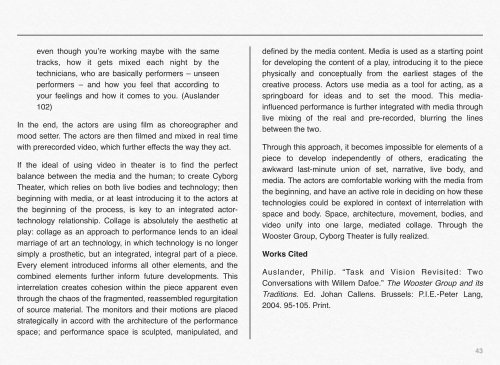Digital Arts & Humanities - Scholarly Reflections - James O'Sullivan
Digital Arts & Humanities - Scholarly Reflections - James O'Sullivan
Digital Arts & Humanities - Scholarly Reflections - James O'Sullivan
Create successful ePaper yourself
Turn your PDF publications into a flip-book with our unique Google optimized e-Paper software.
even though you’re working maybe with the same<br />
tracks, how it gets mixed each night by the<br />
technicians, who are basically performers – unseen<br />
performers – and how you feel that according to<br />
your feelings and how it comes to you. (Auslander<br />
102)<br />
In the end, the actors are using film as choreographer and<br />
mood setter. The actors are then filmed and mixed in real time<br />
with prerecorded video, which further effects the way they act.<br />
If the ideal of using video in theater is to find the perfect<br />
balance between the media and the human; to create Cyborg<br />
Theater, which relies on both live bodies and technology; then<br />
beginning with media, or at least introducing it to the actors at<br />
the beginning of the process, is key to an integrated actortechnology<br />
relationship. Collage is absolutely the aesthetic at<br />
play: collage as an approach to performance lends to an ideal<br />
marriage of art an technology, in which technology is no longer<br />
simply a prosthetic, but an integrated, integral part of a piece.<br />
Every element introduced informs all other elements, and the<br />
combined elements further inform future developments. This<br />
interrelation creates cohesion within the piece apparent even<br />
through the chaos of the fragmented, reassembled regurgitation<br />
of source material. The monitors and their motions are placed<br />
strategically in accord with the architecture of the performance<br />
space; and performance space is sculpted, manipulated, and<br />
defined by the media content. Media is used as a starting point<br />
for developing the content of a play, introducing it to the piece<br />
physically and conceptually from the earliest stages of the<br />
creative process. Actors use media as a tool for acting, as a<br />
springboard for ideas and to set the mood. This mediainfluenced<br />
performance is further integrated with media through<br />
live mixing of the real and pre-recorded, blurring the lines<br />
between the two.<br />
Through this approach, it becomes impossible for elements of a<br />
piece to develop independently of others, eradicating the<br />
awkward last-minute union of set, narrative, live body, and<br />
media. The actors are comfortable working with the media from<br />
the beginning, and have an active role in deciding on how these<br />
technologies could be explored in context of interrelation with<br />
space and body. Space, architecture, movement, bodies, and<br />
video unify into one large, mediated collage. Through the<br />
Wooster Group, Cyborg Theater is fully realized.<br />
Works Cited<br />
Auslander, Philip. “Task and Vision Revisited: Two<br />
Conversations with Willem Dafoe.” The Wooster Group and its<br />
Traditions. Ed. Johan Callens. Brussels: P.I.E.-Peter Lang,<br />
2004. 95-105. Print.<br />
43


